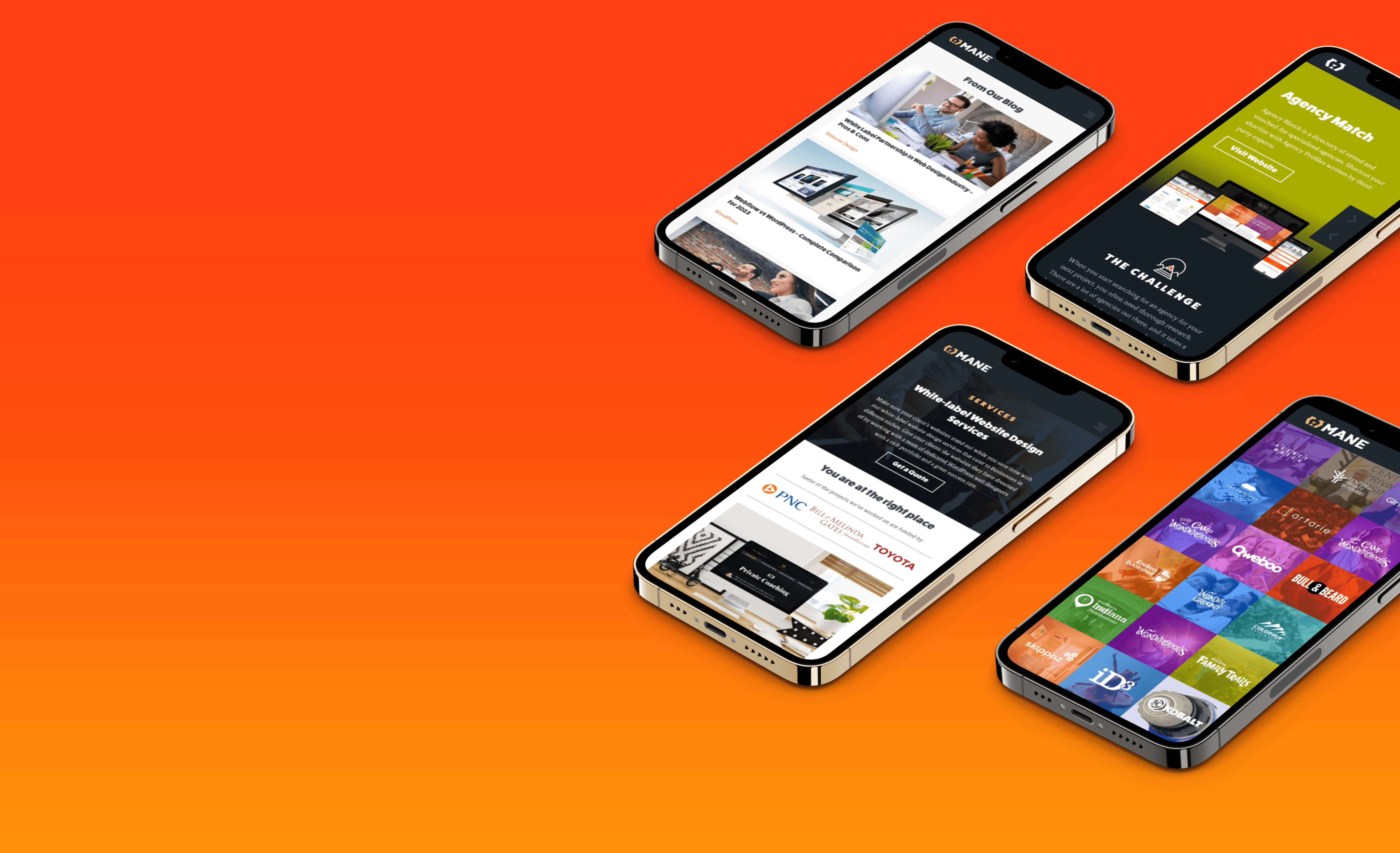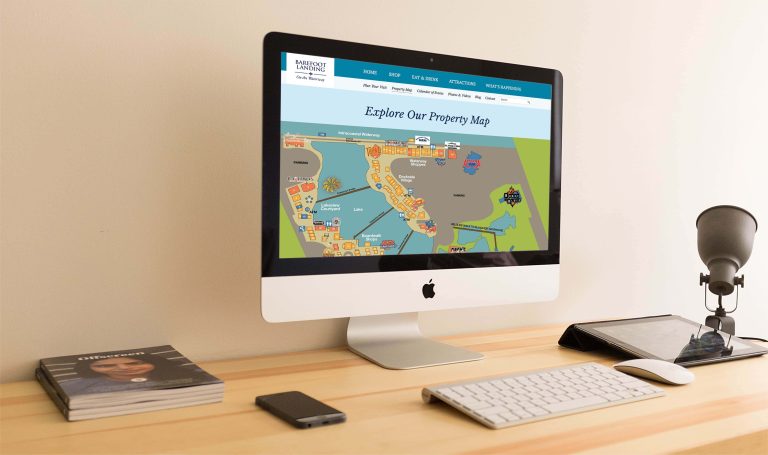
How to Make a WordPress Website Mobile-friendly
Intro
The numbers are precise, and the shift towards mobile browsing is undeniable. In the US alone, mobile devices accounted for 64% of Google searches in Q3 2021, and this trend continues globally with almost 60% in Q3 2022.
This trend highlights the need for a mobile-friendly website, especially considering that 80% of smartphone users prefer brands whose websites and apps are optimized for mobile use.
WordPress has long emerged as a popular Content Management System (CMS) that businesses, organizations, and individuals widely use. With its vast collection of themes and powerful plugins, WordPress offers immense potential for creating an engaging mobile experience.
However, building a mobile-friendly WordPress website requires strategy, design, and technical know-how. This article outlines the key steps and considerations involved in achieving this.
Why is it essential to have a mobile-friendly site?

Besides the usage and a growing mobile audience, there are multiple practical reasons why you should build a mobile-friendly, responsive WordPress website:
Improved User Experience (UX)
A mobile-friendly website provides a better user experience for visitors on mobile devices. It ensures that your site is easily navigable, readable, and functional on smaller screens, which helps keep users engaged and reduces bounce rates.
Enhanced Search Engine (SEO) Rankings
Search engines like Google prioritize mobile-friendly websites in their search results, a practice known as mobile-first indexing. Having a mobile-optimized site significantly improves your search engine rankings, making it easier for potential visitors to find your site.
Reduced Maintenance
With responsive design, you can maintain a single website that adjusts to various screen sizes rather than having separate versions for desktop and mobile. This reduces the time and resources spent on website maintenance.
Faster Loading Times
Mobile-friendly websites are generally optimized for faster loading, which is crucial for mobile users who often access the internet on the go. Faster loading times lead to better user engagement and reduced bounce rates.
Higher Conversion Rates
A website optimized for smartphones can lead to higher conversion rates. If the process is straightforward on a mobile device, users are likelier to take action, such as purchasing or signing up for a newsletter.
Social Media Integration
Mobile users are often also heavy social media users. A mobile-friendly website is more likely to be shared on social media platforms, increasing your website’s visibility and traffic.
Competitive Advantage
A mobile-friendly website can give you an edge over competitors who haven’t optimized their sites for mobile users. It shows that you are keeping up with technology and catering to the needs of your audience.
Adaptability to Wearables and IoT Devices
Mobile-friendly websites are more adaptable to new sizes and types of hardware that may soon become more popular, such as smartwatches and other IoT devices.
Difference between mobile-friendly and responsive sites
“Mobile-friendly” and “responsive” are related concepts in web design, but they are not precisely the same. Each term focuses on optimizing websites for mobile devices, but they approach it differently.
While all responsive sites are inherently mobile-friendly, not all mobile-friendly sites are responsive. Mobile-friendly is a broader concept that means a website functions well on mobile devices, whereas responsive refers to the specific method of dynamically adapting the site’s layout to various screen sizes and devices.
A mobile-friendly website works well on mobile devices, typically through a design compatible with mobile screens and functionalities.
Responsive design is a specific approach to web design where the site layout dynamically adjusts and reshapes to fit different screen sizes and devices.
The decision between responsive and mobile-friendly design can depend on specific business needs and user demographics. For example, if your audience predominantly uses smartphones and your website serves a singular purpose, a mobile-friendly site might suffice.
A responsive website is generally the superior choice for most scenarios, especially when targeting a diverse audience with varying device preferences.
Tips on how to make your WordPress website Mobile Friendly

Choose a responsive WordPress theme.
The good news is that most new WordPress themes are responsive and adjust to different screen sizes and devices.
However, keeping your WordPress and theme versions up-to-date is still essential. Updates often include enhancements or fixes for mobile-friendly features, which can improve user experience and resolve any potential issues.
If you find that updates are not fully addressing your concerns about responsiveness, consider switching to a newer, more mobile-optimized theme. Alternatively, you can create a custom theme tailored to your specific mobile-friendly requirements with the necessary skills or resources.
Use mobile-optimized plugins
A WordPress plugin is a software add-on that integrates with your WordPress site, enhancing its functionality without necessarily altering its visual front-end design. They add diverse capabilities, from SEO to social media integration, without the need for extensive coding.
However, ensure that the plugin you choose scales across different screen sizes. If the plugin introduces visual elements like widgets or Call-To-Action (CTA) buttons, it should be responsive or provide the option to disable them on smaller screens.
Research each plugin
Before you add a new plugin, it is wise to examine its features carefully. Reading reviews and exploring demos can give you valuable insights into the plugin’s performance and mobile responsiveness, similar to selecting themes.
After activating the plugin, it is essential to conduct a quick quality check to ensure that everything functions correctly across various devices. This approach, combined with a responsive theme, will ensure that your site maintains its aesthetic and functional integrity, providing a smooth user experience on desktop and mobile platforms.
Remember, the synergy between a responsive theme and well-behaved plugins ensures your WordPress site shines on smaller screens.
Mobile and desktop content should be the same.
Due to Google’s mobile-first indexing approach, aligning your website’s content on mobile and desktop versions is not a best practice but a requirement. A difference in content, mainly if the mobile site provides less information than the desktop, can result in significant traffic loss.
Therefore, it is crucial to maintain consistent titles, metadata, and structured data across both versions. Also, ensure uniformity in text, file names, captions, and alt text for images.
For websites with a lot of content, instead of reducing content for mobile users, adapt it using mobile-friendly design elements such as accordions, drop-down menus, or tabs. These features provide a structured, easy-to-navigate way to display comprehensive content on small screens.
Compress your files
Since phones and tablets usually have less processing power and bandwidth than desktops, efficient data usage is critical. That’s why compressing files is an essential step to improve the mobile responsiveness of your WordPress website.
For example, while visually appealing, large high-resolution images and animations can significantly slow down your site on mobile devices. To address this issue, you can utilize WordPress plugins that compress and optimize different file types.
Here is a comprehensive list of file types, formats, and plugins to help you learn more about how to compress WordPress files:
Image Files
Types: JPEG, PNG, GIF, WebP.
Compression: Use plugins like WP Smush, EWWW Image Optimizer, or ShortPixel to compress images upon upload automatically. These tools can perform lossless or lossy compression, reduce image dimensions, and convert images to more efficient formats like WebP.
Mobile Benefit: Reduces image file size for faster loading on mobile devices, improving user experience and mobile data consumption.
HTML, CSS, and JavaScript Files
Compression: Use minification tools that remove unnecessary characters (whitespace, comments, etc.) from HTML, CSS, and JavaScript files. Plugins such as Autoptimize, W3 Total Cache, or Hummingbird can handle this automatically.
Mobile Benefit: Smaller file sizes lead to faster page loading times, which is crucial for mobile users with slower internet connections.
Videos
Types: MP4, WebM, AVI.
Compression: Host videos on platforms like YouTube or Vimeo and embed them in your WordPress site instead of uploading them directly. These platforms automatically optimize video for various devices.
Mobile Benefit: Improves loading times and saves bandwidth on mobile devices while ensuring videos are playable across all platforms.
PDFs and Other Document Files
Compression: Use tools like Adobe Acrobat for PDF optimization or plugins such as ShortPixel, which also optimizes PDF files.
Mobile Benefit: Faster document load times enhance the user experience on mobile devices.
Fonts
Types: Web fonts like Google Fonts or custom font files.
Compression: Employ modern, efficient font formats, e.g., WOFF2, and limit the number of font variations (weights, styles) to reduce file size.
Mobile Benefit: Reduces font loading times, ensuring quicker page rendering on mobile.

Correctly embed external content.
Incorporating embedded content into a website can significantly improve user engagement and add value to the site. It enables the integration of various media forms, such as videos, social media posts, and interactive maps, making the website more interactive and visually appealing.
Diverse media types can keep users engaged for extended periods, which may help reduce bounce rates. Additionally, embedding content such as social feeds or videos can help conserve server resources and simplify content updates.
Moreover, it has the potential to enhance SEO by increasing the time users spend on the website and providing opportunities for backlinks from shared, embedded content.
When embedding external content on a WordPress website, it’s essential to consider various factors to ensure a mobile-friendly experience. Here are some tips:
Use Responsive Embeds
Ensure the embedded content is responsive, meaning it automatically adjusts its size based on the viewer’s screen size. Most modern WordPress themes support responsive embeds by default.
Utilize WordPress’s Embed Blocks
Use WordPress’s built-in embed blocks for popular services like YouTube, Twitter, and Instagram. These blocks ensure that the embedded content is mobile-friendly.
Avoid Fixed Widths and Heights
Avoid using fixed widths and heights in your HTML or CSS when embedding content manually. Instead, utilize relative units such as percentages for width and set the height to auto.
Test on Multiple Devices
After embedding, test how the content looks on various devices. You can use device emulation features in web browsers or physically test different mobile devices.
Opt for Quality over Quantity
Embed only the essential external content. Excessive embedded items can slow page loading times, negatively impacting mobile users.
Consider Lazy Loading
Implement lazy loading for embedded media. This means the content only loads when it’s about to enter the viewport, reducing initial page load time.
Simplify navigation
Mobile users typically require a simple and intuitive way to navigate your website. Complex navigation structures with many options and sub-menus overwhelm and lead to a poor user experience on small screens.
That’s why it may be better to focus on showing only the main categories and avoid too many sub-categories unless absolutely necessary.
One standard solution for mobile sites is to implement a hamburger menu, which neatly hides menu options to free up screen space while providing easy access to your entire site.
Another approach is using a sticky navigation bar that remains visible as users scroll, offering continuous, easy access to key sections of your site.
A tabbed navigation structure at the bottom of the screen can be a highly user-friendly option for more straightforward websites or apps with a few distinct sections.
Write your copy mobile-friendly
Creating mobile-friendly content involves strategies that enhance readability and engagement on smaller screens. Here are the fundamental approaches:
Concise and Clear Writing: Utilize short, straightforward sentences and paragraphs. Mobile users often scan content, so get to the point quickly.
Subheadings and Bullet Points: Break up text with subheadings and bullet points for easier scanning. This helps users quickly find the information they need.
Larger Font Sizes: Employ a larger font size for improved readability on small screens. Avoid stylistically complex fonts.
Contrast and Color: Ensure high contrast between text and background colors. Good contrast reduces eye strain, especially on smaller screens.
Touch-friendly Links and Buttons: Make links and call-to-action buttons large enough to be easily tapped on a touchscreen.
Short and Compelling Headlines: Craft headlines should be brief and engaging, as they are often the first thing mobile users see.
Avoid Large Blocks of Text: Break long text into smaller, more digestible chunks. Long paragraphs can be daunting on small screens.
Use of Multimedia: Incorporate multimedia elements, e.g., infographics or short videos, which can be more engaging than text-heavy content on smaller screens.
Be careful with pop-ups.
Google penalizes websites that display intrusive interstitials, such as pop-ups that block significant portions of content and negatively affect the user experience.
Google recommends avoiding intrusive interstitials that can make content less accessible and using alternatives like banners or inline forms that don’t block the main content.
Thankfully, most pop-up providers offer the option to turn off these intrusive elements on mobile devices. This feature ensures that your website complies with Google’s guidelines, avoids potential penalties, and provides mobile users with a smooth and engaging experience.
Here are five rules for mobile and user-friendly pop-up design abiding by Google’s guidelines:
- Non-Intrusive Size: Ensure pop-ups are small and don’t cover significant portions of the screen, especially the main content and the H1 heading.
- Easy Dismissal: Include a clear and easy way to dismiss or close the pop-up without hassle.
- Timing and Frequency: Avoid immediate pop-ups upon page entry; delay or trigger them based on user interaction.
- Legally Required Exceptions: Only employ full-screen interstitials for legal requirements, such as age verification or cookie consent.
- Relevance and Value: The pop-up should offer relevant and valuable content to enhance, not disrupt, the user experience.
Forget about Flash
Don’t use Flash to create mobile-friendly websites, primarily because most iOS devices do not support it, and Androids have limited support.
Also, Flash tends to slow down page loading times and negatively impact UX design and SEO. Instead, apply modern web standards such as HTML5, CSS3, and JavaScript.
These technologies are compatible across all mobile browsers and offer greater functionality. For example, HTML5 allows for creating interactive content and animations, similar to Flash, but in a more efficient and accessible way.
Add social sharing buttons.
Although social sharing buttons are useful for WordPress websites, most social sharing plugins are not fully optimized for small screens. They usually offer options to display buttons above or below content or as a floating sidebar.
However, on devices with limited screen space, these buttons can occupy too much space and negatively affect the user experience.
To fix this problem, it’s recommended to go to the plugin settings and turn off the floating sidebar in mobile view. If the plugin doesn’t provide this option, turning off the floating sidebar feature altogether is better.
Optimize for eCommerce
WordPress websites created with WooCommerce themes are usually designed to be responsive from the outset, which ensures a well-ordered shopping experience on all devices.
However, if you have chosen a different WordPress theme or have a custom-designed site, working proactively with your web designer to optimize your store for mobile users is essential.
This means your product images should adjust according to the screen size, avoiding any cutoffs. The shop buttons should not exceed the allowable screen size, ensuring they don’t appear cropped. The input fields on the order form should trigger the correct type keyboard for the corresponding field, and checkout is a streamlined process with minimal steps and uncluttered, easy-to-use forms.
Also, consider integrating options like guest checkout and easy payment methods (Apple Pay or Google Wallet) to enhance mobile user convenience.
Pay attention to page loading times.
Page speed is a crucial factor impacting search rankings on both desktop and mobile devices. An eCommerce site that loads in 1 second has a conversion rate 2.5x higher than a site that loads in 5 seconds. In WordPress, several vital factors influence page loading times:
Web Hosting: Your hosting provider and plan significantly affect site speed. Opt for a reliable hosting service with sufficient resources and speed optimization features.
Image Size and Optimization: Large, unoptimized images can drastically slow down your site. Apply image compression tools and formats, e.g., JPEG or WebP, for faster loading.
Plugins: Too many poorly coded plugins can slow down your site. Review and deactivate unnecessary plugins regularly and choose well-coded, optimized plugins.
Themes: Some themes are heavy and bloated with unnecessary features. Select a lightweight, performance-optimized theme or build a custom WordPress site.
Caching: Lack of proper caching can increase load times. Implement caching solutions like W3 Total Cache or WP Super Cache to store and serve frequently accessed resources efficiently.
To improve these factors, regularly audit your site’s performance using tools like Google PageSpeed Insights. Taking measures to improve these factors will significantly enhance your WordPress site’s loading speed, contributing to better user experience and SEO.
Test all changes
After customization of each WordPress site, test your pages for usability and performance. Consistent testing also plays a crucial role in maintaining accessibility standards, ensuring the site is usable for users with disabilities.
Therefore, incorporating regular testing into the development process is critical, striking the right balance between functionality, aesthetics, user experience, and overall performance.
How to test for mobile-friendliness?

A comprehensive mobile friendliness test evaluates several vital aspects to ensure optimal performance and user experience on mobile devices. Here are the primary elements it looks at:
Responsive Design: This check ensures that the website layout accurately adjusts to various screen sizes and orientations, ensuring that content is easily readable and navigable without needing to zoom.
Load Time: Assesses the loading speed of the website on mobile devices. Fast load times are crucial for keeping mobile users engaged.
Touchscreen Readability: Ensures buttons and links are easily clickable, appropriately sized, and spaced.
Text Readability: Verify that text, including font size and line spacing, is legible on small screens without zooming.
Image Optimization: Looks at whether images are optimized for mobile viewing, ensuring they load quickly and fit the screen dimensions.
Viewport Configuration: Checks if the website uses a viewport meta tag to control layout on mobile browsers.
Content Scaling: Tests whether content scales correctly for different devices, preventing horizontal scrolling or misaligned elements.
Interstitials and Pop-Ups: Evaluate whether pop-ups or interstitials hinder the mobile user experience, as they can be more obtrusive on smaller screens.
Google Lighthouse Audit
Google Lighthouse is a free, comprehensive tool that covers most of the above aspects. When you run a Lighthouse audit, it evaluates aspects such as performance, accessibility, best practices, and SEO, making it a valuable tool for assessing and improving a website’s mobile usability.
However, additional manual testing or complementary tools might be necessary for certain specific elements like the impact of interstitials and exact touchscreen functionality.
To run Google Lighthouse on any single URL in Google Chrome, press Ctrl+Shit+I (or right-click and select Inspect) and click the Lighthouse tab.
Google Search Console
It is a comprehensive tool for detecting all kinds of technical issues, especially useful for analyzing website traffic. You can utilize Google Search Console to reliably check your website’s mobile friendliness.
Google Search Console offers the Mobile Usability Report tool to help website owners identify issues affecting their site’s performance on mobile devices.
First, you must verify and claim your website’s property to use Google Search Console. This is an essential tool for any website, so familiarize yourself with it.
Cross-Platform Testing
For example, analyze how exactly your website renders on the latest version of Mozilla Firefox using a Samsung tablet device. Many software solutions are available for cross-platform testing.
They provide:
- A variety of virtual environments.
- Simulating a wide range of devices.
- Operating systems.
- Browser combinations.
Developers and designers employ these tools to thoroughly test and fine-tune their websites and ensure a consistent and optimal user experience across all potential user scenarios.
Conclusion
The journey to making your WordPress website mobile-friendly centers on delivering an exceptional User Experience (UX). It’s about creating a site that is aesthetically pleasing on mobile devices and functions seamlessly, offering users an intuitive, accessible, and engaging experience.
Each step is pivotal in enhancing your website’s mobile presence, from choosing responsive themes and optimizing images to simplifying navigation and ensuring fast loading times.
Embracing mobile-friendliness is not a trend; it’s a fundamental aspect of reaching and engaging the modern consumer. That’s why we encourage all businesses and website owners to implement these tips in their digital marketing efforts.
If you find these tasks daunting or require expert assistance, MANE Digital is here to assist you. Our expertise in Custom WordPress Development, Web Design, and Website Speed Optimization positions us uniquely to elevate your website’s performance.
Trust us to tailor a solution that meets your business needs and enhances your online impact. Reach out to MANE Digital today, and let’s create a mobile-friendly experience that resonates with your audience and drives your business forward.


